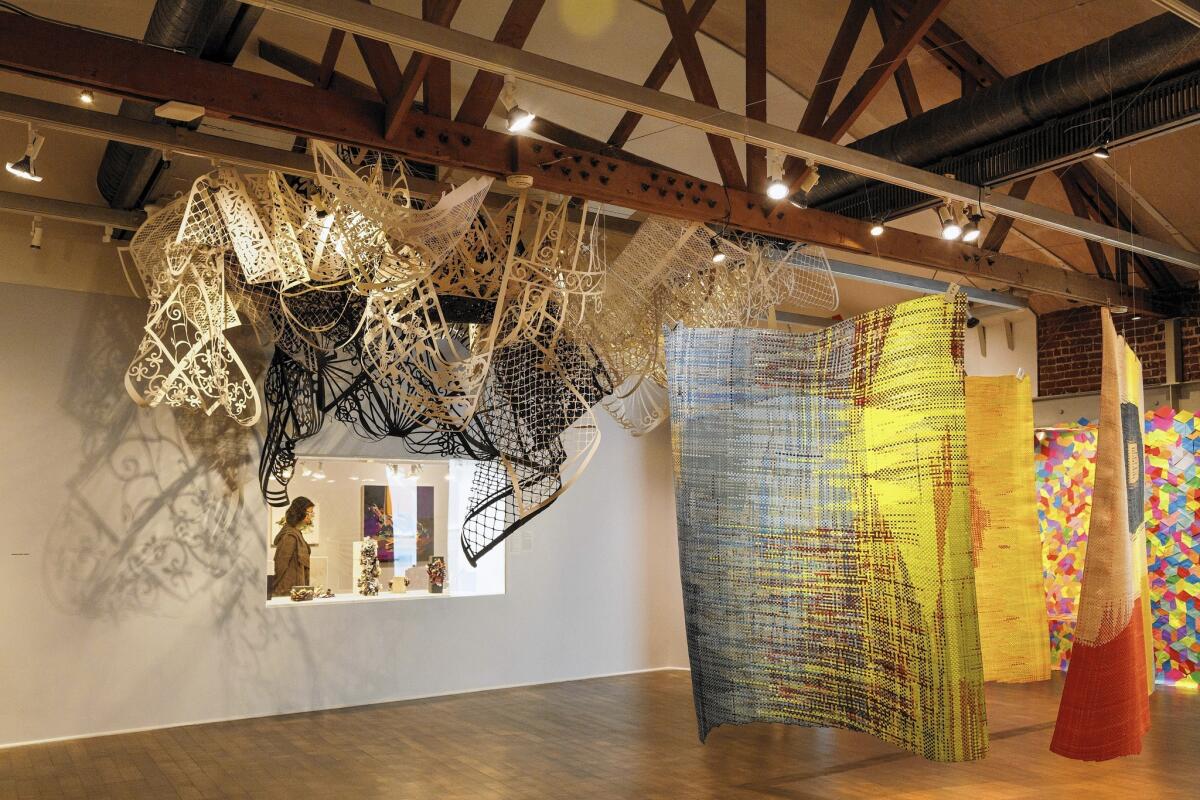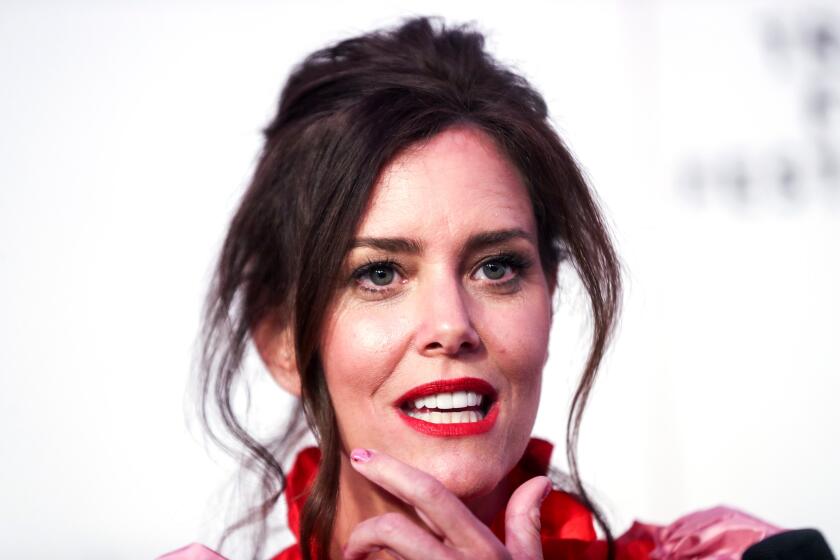On Craft & Folk Art Museum’s golden anniversary, ‘Paperworks’ is a cutting-edge gift

- Share via
The jungle is a magical one, dense with dangling vines and voluminous blossoms awash in green and gold glitter. The foliage sways in the breeze, casting glimmering shadows that dance on a nearby wall to the chorus of crickets chirping, leaves rustling and crows cawing.
Chris Natrop’s hand-cut paper forest at the Craft & Folk Art Museum is part of the exhibition “Paperworks,” which features sculptures, collages and large-scale installations by 15 contemporary artists working in unusual ways with paper.
Using a somewhat crude box-cutting knife, Natrop carved a 3-D forest that is backed by video from his own garden. The color-washed paper forms, often with rough or frayed edges, dangle from the ceiling and drape along the floor like an overgrown yard, the organic sounds from his garden bringing the installation to life.
SIGN UP for the free Essential Arts & Culture newsletter >>
“The show is wildly diverse in terms of how the artists are approaching paper, the techniques that they’re using,” said Howard N. Fox, the guest curator behind the exhibition and curator emeritus of contemporary art at the Los Angeles County Museum of Art. “We’ve got at least four or five nationalities by birth represented in the show, artists of different sexual orientations, all different cultural traditions. The one through-line is the interest in paper as a primary medium.”
“Paperworks,” on view through Jan. 3, is one of two shows marking the museum’s 50th anniversary. It was founded in 1965 by artists Edith R. Wyle (actor Noah Wyle’s grandmother) and Bette Chase as a commercial gallery and cafe called the Egg & the Eye, showcasing contemporary crafts and ethnic folk art.
“You’d have to pass through the Sam Maloofs and Beatrice Woods to get to the restaurant,” museum Executive Director Suzanne Isken said of the gallery, which transitioned into the private, nonprofit Craft & Folk Art Museum in 1973. “Edith was passionate about, and just wanted to share, the really interesting things people were doing with a craft focus. And that’s exactly what we’re doing today.”
“Paperworks” is a particularly appropriate show to mark the anniversary, Isken said. The exhibition highlights — albeit through a particularly modern and experimental lens — one of the most elemental materials in craft work.
“Paper has a tremendous history as a material,” Isken said. “But what we’re trying to do at CAFAM is take a traditional craft material and show how people are using it in more contemporary and innovative ways. Here it’s about the manipulation of paper — cutting it, ripping it, squeezing it, tearing it, folding it, crumpling it. That sense of exploding the boundaries has been really interesting to us.”
Tm Gratkowski’s work in the show is seemingly explosive: His mold-cast concrete boxes erupt with glossy, crumpled paper. The bundle of scrunched, recycled magazine pages have an almost floral quality to them, as if they were petals arranged in a concrete cube. At the same time, they could be volatile, fire-filled scientific experiments gone awry.
See the most-read stories in Entertainment this hour >>
Tam Van Tran’s aggressive, wall-mounted sculptures — tinted with homemade paints made from spirulina and beet juice — appear almost reptilian. It’s as if the preserved backside or exterior shell of some prehistoric creature were busting through the museum’s walls. To enhance texture, Van Tran uses quotidian office supplies on paperboard. One “animal form” is covered in three-hole-punch cutouts and shiny, metallic staples that appear to be a glistening fur.
Perhaps the most painstakingly laborious works in the show are the deconstructed books of Susan Sironi. One three-piece display includes a clear plexiglass box filled with what appears to be cream-colored sand. But on closer inspection, the box is filled with the loose, individual letters from a vintage book, each character hand-cut from its pages. An adjacent plexiglass box is filled with orange and yellow-tinted swirls, slices of illustrations that also were cut from the book; layered flat inside the box, it appears to be sand art when seen from the side. Sironi left the skeleton of the book largely hollowed out but for outlines of the illustration cutouts, which are tangled up inside its frame like knotted cassette tape or overgrown weeds.
The artist Phranc — who for years boasted the title “the world’s only singing, lesbian, Tupperware-lady performance artist” — created realistic-looking, seashore-themed clothing items from corrugated cardboard and paper. She followed actual sewing patterns when assembling her handmade fabric to create an orange life vest, polka dot swimming shorts and beach umbrella with a 1950s vintage sewing machine.
A few two-dimensional works are in the show, more aligned with collages, weavings or drawings, but even they show the manipulation of paper in unusual ways. Lecia Dole-Recio’s abstract works appear to be collages, but they’re more akin to assembled mosaics — each geometric “tile,” in stained-glass jewel tones, applied individually to the panel.
Francesca Gabbiani’s detailed collages are so layered, they appear almost three-dimensional. Each features structures — a shed or a cabin — in nature, but with an undercurrent of imminent destruction.
Minoru Ohira gauges textured swirls into painted, five-ply Japanese paper with a razor blade; Lorenzo Hurtado Segovia weaves together thin strips of painted paper to create colorful, almost pixelated “rugs” that blur the distinction between fabric art and basketry.
Collectively, the works in the exhibition celebrate not only 50 years of craft on view at the museum, but the resilience and versatility of paper itself.
“We think of paper as sort of obsolescent now — the ideal of the green office, the paperless office,” curator Fox said. “But it’s being rediscovered, almost, as a wonderfully, infinitely manipulable material. And that’s the beauty of this show.”
MORE:
Jane Pisano is leaving L.A.’s Natural History Museum far brighter than she found it
Todd Carpenter paints urban and woodsy landscapes in a scientific light
How these 75-plus murals have turned three L.A. alleys into an outdoor art gallery
More to Read
The biggest entertainment stories
Get our big stories about Hollywood, film, television, music, arts, culture and more right in your inbox as soon as they publish.
You may occasionally receive promotional content from the Los Angeles Times.











